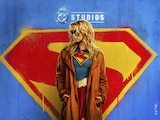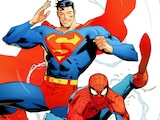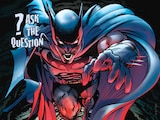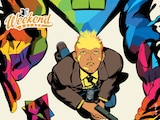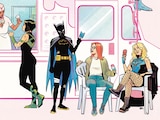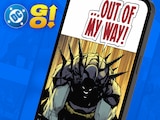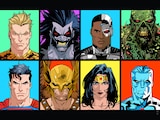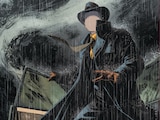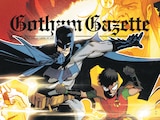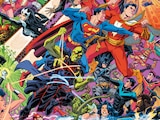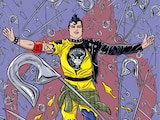Welcome to another edition of ASK…THE QUESTION. I’m Alex Jaffe, better known as HubCityQuestion in the DC Official Discord server. You’ll find me in the #ask-the-question channel answering or otherwise researching any great or small mystery you have about the DC Universe in all of its incarnations. I’m here to share some of the most interesting questions that crossed my desk this month. Hopefully you learn something today. And if there’s still something DC-related on your mind that’s driving you crazy at night, make sure to stop by and see me in my office.
Now, let’s get some answers.

Dr. Quinzel asks:
How does Shazam tell people his name?
From 1940 until 2011, he called himself "Captain Marvel." He only started using the name “Shazam” in 2011. At first, during Geoff Johns' Justice League run, there was a sort of intentionality clause where he would only transform while saying “Shazam” if that's what he wanted to do. From about 2018 to 2023, though, he just avoided saying his name out loud altogether. These days, he’s been going by "The Captain," so it’s largely a non-issue.
superthebillybob asks:
Are there any DC heroes and villains with canonical food allergies?
According to Tom King's The Human Target, Guy Gardner is allergic to peanuts. That's a Black Label series, though, so that may or may not be true in mainstream continuity. Similarly, on Smallville, Oliver Queen was also depicted with a peanut allergy. In the CW’s “Arrowverse,” Kelly Olsen, who becomes Guardian in season six of Supergirl, has a deadly allergy to blueberries. Caitlin Snow is allergic to cinnamon, Ryan Choi is allergic to most forms of alcohol and in the final episode of the Teen Titans animated series, Terra apparently returned to life with a mysterious new allergy to anchovies.

Something asks:
How did Wonder Woman get her name? Specifically, the modern version of the character.
According to the latest version of her origin story, the newspapers settled on that name for her upon rescuing hostages from a group of Ares cultists who had taken over the UN International School building shortly after arriving in man's world. Just prior to the rescue, it’s implied that a reporter overheard Diana say “I am wonder” in her recently acquired, broken English, and applied it to her name.
King Komodo asks:
At the end of Infinite Crisis, Guy Gardner says Superboy Prime is in a cell made with (something something) baby red sun eater…courtesy of Donna Troy?! Why does Donna Troy have access to sun eaters? Is this a Darkstars thing?
It's actually a Return of Donna Troy thing, from her 2005 miniseries. In that book, set shortly before Infinite Crisis and re-exploring her origins amongst the Titans of Myth, Donna encounters a "Sun-Eater Factory" on the planet Minosyss. At the end of the series, Donna manages to save the factory from a critical mass that may have wiped out the entire universe and gains the favor of the Titan Coeus, who claims responsibility for the factory going forward. It's here that Donna had access to baby sun eaters.

Reaganfan78 asks:
In Batman: Caped Crusader, the Penguin is a female character. Has this ever happened to other DC villains?
It has, from time to time. In fact, it's quite common.
The Joker has been portrayed as a woman on multiple occasions, including the Elseworlds comic Batman: Thrillkiller, and the Flashpoint saga. The assassin Copperhead was reintroduced as a woman in the video game Batman: Arkham Origins and that took to the comics from there. Two iterations of the Ventriloquist, Peyton Riley and Shauna Belzer, were women in the comics. Sondra Fuller, "Lady Clay," was a female incarnation of Clayface. A female version of Bane named "Vengeance" was introduced in James Tynion's The Joker. And Firefly was reinterpreted as a woman, Bridgit Pike, on the Gotham TV series.
There have been more! I won't attempt to list every one of them here, but this case of the Penguin in Batman: Caped Crusader is merely the latest example.
Selim asks:
Do the Blue Lantern Corps really need to be around a Green Lantern to make constructs?
They did initially, but the Blue Lantern Corps is relatively young. The last time we saw them active, we saw them beginning to discover how to circumvent that limitation by channeling their own will—much like how Green Lanterns once had a weakness to the color yellow before they figured out a way around it.

Morgie asks:
Pertaining to Absolute Power #2, when did the bottle city get repopulated? I could have sworn that it didn't have any people in it anymore and only the half Zod had did.
Nope, Superman's half of Kandor was populated as well, as seen in 2020's Batman/Superman #8, "The Kandor Compromise: Part 2." Superman's half was merely in stasis—a fact the Brainiac Queen herself alludes to in Absolute Power #2. Mark did his homework.
DrWhoDidle asks:
I’m reading Gotham Central and there’s frequent mention of Harvey Bullock and Renee Montoya having been partners at some point. Was there a particular Batman or Detective Comics run that showed them as partners or was this one of those things that was canon and shown in multiple runs for a really long time?
Montoya and Bullock were paired up frequently through the ’90s. After Montoya was introduced as Bullock’s partner in Batman: The Animated Series, it wasn’t too long before that relationship was translated into the comics. Following “Batman: No Man’s Land” in Greg Rucka’s Detective Comics #742, Harvey Bullock was promoted to Lieutenant, and Crispus Allen was introduced as Montoya’s new partner.
Souron1 asks:
What’s the oldest Batman comic in which a member of the creative team is still alive?
That's a very good question! I had to do some research to verify this, but that title goes to 1950's World's Finest #47, featuring the Batman story "Crime Above the Clouds." That story was inked by Sy Barry, best known for drawing The Phantom comic strip for over thirty years. He's currently 96 years old.

GetSnart asks:
When did Riddler first have red/orange hair in the comics? Because I know he had black hair originally.
We got our first redheaded Riddler on Batman: The Animated Series, but it wouldn’t make the transition to comics until a while after. Around the time of “Batman: War Games” in 2004, we see it start fluctuating between black and a brown or auburn. During this time, colorists would sometimes shift it as far as red, such as in Detective Comics #808 in 2005, but it didn't stay that way for years to come.
We finally start seeing a definite shift to red in 2010's Batman #698, when Tony Daniel brought Riddler back from his "reform" era into villainy again. By the New 52, it would be a permanent fixture.
D-Lo43 asks:
The Milton Glaser DC logo is returning (hurray!). Who initially commissioned Milton to make it and was he already a famous graphic designer at the time?
The DC Bullet was originally commissioned by Jenette Kahn, as one of her first acts upon stepping up as DC’s publisher in 1976, to coincide with officially changing the name of the company from National Periodical Publications to DC Comics. It was an extremely savvy move, with Glaser’s fame well on the rise, but it wasn’t a blind connection—Kahn and Glaser already had a pre-existing relationship working on Smash Magazine together before she started at DC. A year after giving us his DC logo, Glaser would gain his worldwide renown by designing the famous heart logo for the city of New York.

Jurisdiction asks:
How does Aquaman communicate with sea creatures? I feel like I've read somewhere that it's not actually telepathy? Also, is there any canonical explanation as to why Aquaman can't communicate with land animals?
Since the ‘90s, this power has been attributed to an elemental force much like the Green known as "the Clear"—a morphogenic field which connects all sea life. Aquaman is able to communicate with sea life the same way that, say, Swamp Thing can communicate with plants. Sometimes called “the Blue,” the Clear is an overlapping force with the Green and the Red, uniting all sea life. This is how, for example, Beast Boy can transform into marine animals, despite being connected to the Red.
Carter asks:
What on earth was issue #5 of Animal Man by Grant Morrison about? Is it like a Jesus parallel?
“The Coyote Gospel,” as I interpret it—much like later issues of Morrison’s run, and indeed their entire body of work—is about the infinite but unchanging nature of being a fictional character in a perpetual world. No matter what evolution you go through, and no matter what happens to you, your blessing and your curse is to do this forever. Because it’s Morrison, they take the opportunity to draw parallels between comic and cartoon characters forced to bear this Sisyphean state to religious trauma. It’s in line with Morrison’s general philosophy that superheroes are our modern American gods, made to suffer for our benefit.

Medina_Prime asks:
Who is the canon character that named the Justice League? If it’s always different based on universe, who was the first?
The very first origin of the Justice League of America is told in 1962's Justice League of America #9. There, in flashback, it's Barry Allen who suggests they form "a league against evil," "to uphold justice." From that mission statement, the Justice League of America was born.
kii asks:
I want to further my DC knowledge, so which comic should I start at?
There are thousands of ways I could answer this, but the truth is there is no one ideal “starting point.” Just read what you’re interested in and keep reading from there. There’s no fast-track cheat code to knowing it all.
Of course, your next best option is awaiting you in the DC Official Discord server, where you can always ASK…THE QUESTION.
Alex Jaffe is the author of our monthly "Ask the Question" column and writes about TV, movies, comics and superhero history for DC.com. Follow him on Bluesky at @AlexJaffe and find him in the DC Official Discord server as HubCityQuestion.
NOTE: The views and opinions expressed in this feature are solely those of Alex Jaffe and do not necessarily reflect those of DC or Warner Bros. Discovery, nor should they be read as confirmation or denial of future DC plans.

